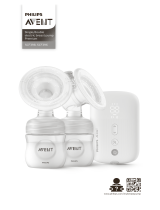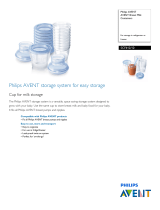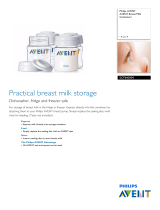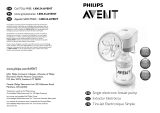
6
GB
Please remember that, should the process become very painful or
uncomfortable, you should stop using the pump and consult your
health professional or breastfeeding advisor.
9) On average you will need to pump for 10 minutes to express 60-125ml
or 2-4oz. However, this is just a guide and varies from woman to woman.
If you find that you regularly express more than 125ml/4oz per session,
please use a 260ml/9oz Philips AVENT bottle or 240ml/8oz VIA cup.
Do not overfill Philips AVENT feeding bottles or VIA cups and keep
upright, otherwise milk may leak from below the pump body.
10. Storing your breast milk
• Breast milk can be stored in
the fridge or freezer in either
sterile breast milk containers
(125ml/4oz or 260ml/9oz
bottles fitted with sealing discs)
or in VIA cups with lids.
• Only milk collected with a sterile pump should be stored to be fed to
your baby.
• Expressed milk should be refrigerated immediately.
• Expressed breast milk can be stored in the refrigerator for up to
48 hours (not in the door) or in the freezer for up to 3 months.
• If you are storing milk in the fridge to add to during the day, only add
milk which has been expressed into a sterile container. Milk can only
be kept like this for a maximum of 48 hours (from first expression)
after which it must be used immediately or frozen for future use.
• For products other than breast milk make feeds up fresh when needed,
following the manufacturer’s instructions.
Storing your milk in the fridge
If your expressed breast milk will be fed to your baby within 48 hours,
it can be stored in the fridge (not in the door) in an assembled Philips
AVENT feeding bottle or VIA feeding system. Assemble a sterilised
teat, screw ring and dome cap and attach onto the body of the Philips
AVENT bottle or the VIA Adaptor and cup (see below).
















